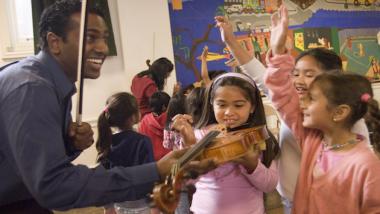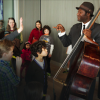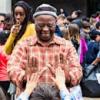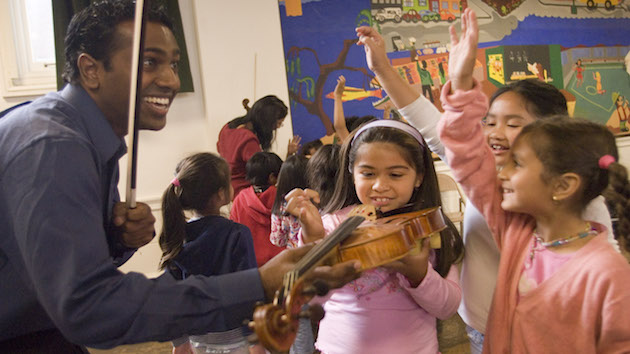
A farmer plants alfalfa seeds and logically expects alfalfa to grow. A parent hums a favorite song or enrolls a child in piano lessons, a busker on the street wields a violin, or an educator has students play tunes on a recorder and the music seed planted renders immense, impossible-to-predict results.
From a child’s fertile mind, there might arise a professional musician, composer, or conductor, gifted teacher, devoted patron of the arts, or an administrator dedicated to delivering arts experience to underserved communities. Scores of studies and research by musicologists suggest and often have data or show evidence that early music experience organizes young brains for learning, teaches discipline and skills used to manage frustration, reinforces team-centric practices, increases global and cultural awareness, empathy, and more.
In other words, music given to children has a way of flowering unexpectedly and bountifully.
Such is the bold premise behind the San Francisco Symphony’s Adventures in Music (AIM) program that in 2018 celebrates its 30th anniversary. Through its three-decade partnership with the San Francisco Unified School District, AIM brings five consecutive years of music experience to all elementary school student grades one through five in every public elementary school in the district.
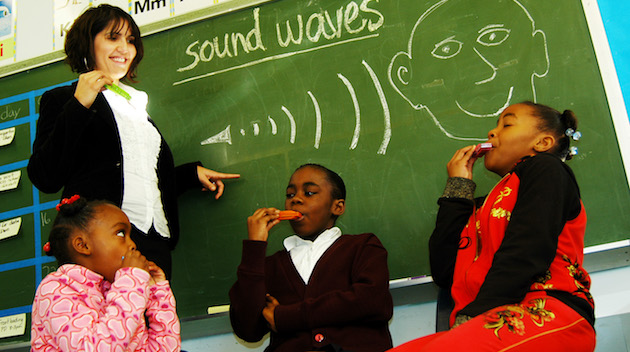
Children, teachers, and schools receive, free of charge, classroom instruction by professional musicians, supplies, instrument repairs, plus opportunities to attend S.F. Symphony open rehearsals and concerts at Davies Symphony Hall. In addition to western classical music and work selected from the symphony’s repertoire, world music chosen to reflect the district’s diverse student population is included. Most recently, AIM programs demonstrated flexibility — within a highly structured scaffold that simultaneously allows adaptation — by adjusting to meet Common Core curriculum and new standards.
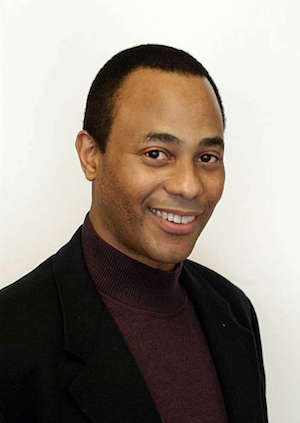
Director of Education Programs Ron Gallman says in an interview that 23,500 students at 82 elementary schools are participating in the program this year. During the 2016–2017 school year, there were 1,144 in-school performances presented to approximately 25,000 students at 95 schools.
Observing the evolution of the program for over 20 years allows Gallman a birds-eye view. “AIM grew out of conversations between the symphony and the district to create a program that would meet the needs of the school district. It was born through that particular partnership. It’s not something the symphony or the school district was doing beforehand.”
Gallman recalls San Francisco undergoing demographic changes in the ’80s. “The city’s fabric was becoming more diverse. As an urban school district, the SFUSD began to mold its system to incorporate that diversity. More schools were dedicated to newcomers, like Spanish speakers with no English. There were elementary schools that were intensive and bridged the languages so students could continue to learn.”
As a conduit connecting cultures and students from diverse backgrounds, AIM was customized to meet specific educational needs, but also involved fluidity. “The main thing that’s happened is that the learning methodologies are always evolving. Common Core and the other curricula before that broadened and changed to embrace cultural diversity much more. There’s an eye toward insuring you are presenting facts and information in a broad enough way that it levels the platform.”
The symphony, according to Gallman, has always embraced cultural diversity, but now includes ideas related to multidisciplinary learning. Education reform occurred coincidentally with AIM as it developed from a pilot program in a few fourth- and fifth-grade classrooms, expanded in its first year to include all fourth- and fifth-grade students, then included third grade shortly thereafter. Bringing it to today’s scale for all students from first through fifth grade was the precursor to the launch of yet another SFS program with a separate, distinct identity. “Having brought the kids in grades one to five to AIM, and ticking along smoothly, we asked schools, “What is your greatest educational need at the middle-school and high-school level?” Band and orchestra groups were bursting at the seams. They had mushroomed. They needed support.”
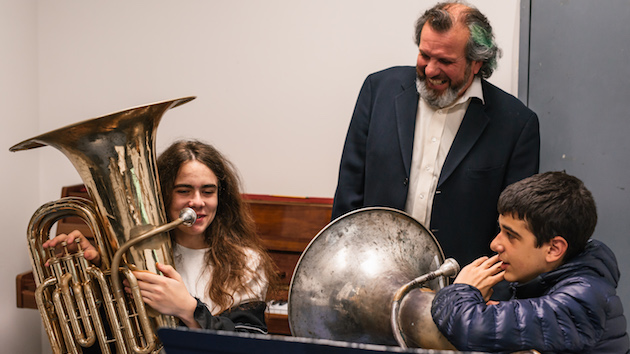
The Music and Mentors program supports all participating instrumental music programs in San Francisco’s public middle schools and high schools, grades six–12. Supplies such as bows, reeds, sheet music, music stands, and more, plus professional mentoring and tickets to concerts and rehearsals are provided free of charge.
Because students receive foundational music experience through AIM in elementary schools, Gallman says, “Schools are seeing students pick up instruments when they have an opportunity. It’s powerful when they make that choice to join a band or orchestra.”
Former AIM student Ruth Cavano, 16, made that choice more than once. After starting piano lessons in kindergarten, she picked up the violin after a field trip to Davies Hall while enrolled in AIM. Being invited to play the “pop” in “Pop Goes the Weasel,” she remembers as thrilling. Exposed to a wider choice of instruments in middle school, she picked up a double bass. “It’s such a big, powerful instrument. Even though you’re in the back, you still feel you drive the orchestra. I just feel connected to it,” she says.
Cavano attends the San Francisco School of the Arts. In addition to performing with the school’s orchestra, she plays with Sunset Youth Orchestra and the S.F. Symphony Youth Orchestra. Music, she says, is a welcome escape that allows her to return to her academic courses with greater focus. “AIM de-stressed me and through music left me with more energy for other things. I was also open to more new things in the classroom. My SFS Youth Orchestra director tells us to play to the people in the back of the hall. The people who can only afford lower price tickets and really want to be there. That can be applied to anything. You can impact people by doing your best for everyday people who’ve tried their best to be there for you.”
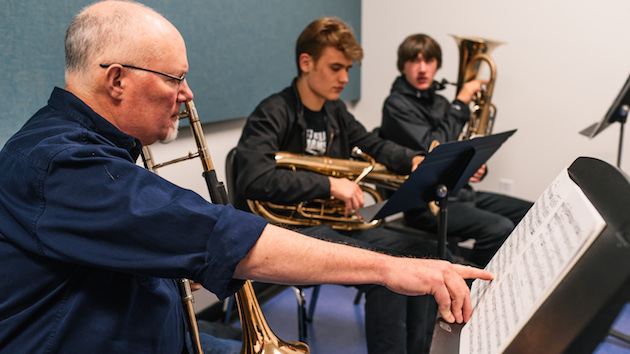
If AIM proves nothing else, the program illustrates that inspired music leadership must begin well before a person enters the concert or rehearsal hall. Instructors with talent in music from all genres and experience in educational settings are necessary to keep classical music vital and future audiences stimulated. “We look for strong communication skills, a malleability of approach,” says Gallman. Based on a theme for a particular year — say, jazz, folk, indigenous, or Latin music, Chinese traditional instruments, a cappella groups, and other categories — the Bay Area’s rich stable of accomplished, professional musicians supports an organic selection process. “We don’t have to go out and hunt; we all know each other,” Gallman says.
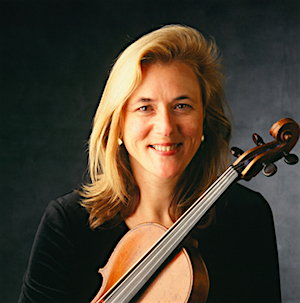
San Francisco native Emily Onderdonk, studied viola and attended Commodore Sloat Elementary school, Aptos Middle School, and Lowell High School. After studying music at Manhattan School of Music, Boston University, and the New England Conservatory, she is a founding member of Quartet San Francisco. “I’ve worked through AIM at every public school in the district. As a [mentor] musician, the greatest challenge is that you don’t know what each school will bring. We need to relate to each group of kids. When it works, it’s incredibly rewarding.”
Children who walk away from AIM ready to try new things or who have learned to listen and respect other people’s opinions leave Onderdonk deeply satisfied. “I’m proud of that. I’ve learned it’s important for people to get along — what the world is struggling with now. We get to connect to all kinds of kids from all different cultures. I see kids I might never see without the program: I get a connection too. We’re treating each other with love, care, and respect.”
A bonus? Onderdonk says the need to keep lessons fresh at each school community has vastly improved her improvisational skills.
If mentors have played a role in shaping AIM — and they have — teachers have also reaped rewards. “Having a set curriculum and goal of going to the symphony allowed me to access history, social studies and different cultures that are impacted by music,” says Sandra Noltimier. She retired in May 2016 after teaching primarily second grade during 27 years at Alvarado Elementary. “AIM tied in to other areas. It enlivened the lessons. All the materials and extras were given to us, without having to have a bake sale to access it.”
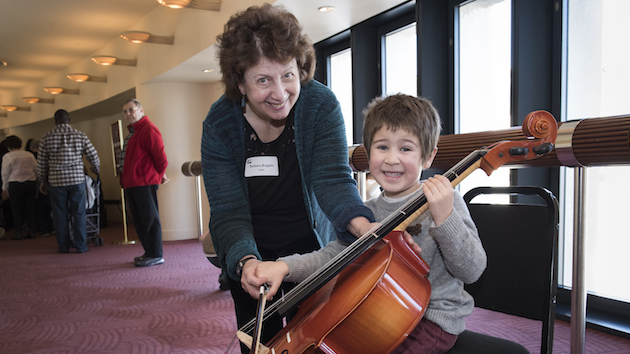
Noltimier witnessed colleagues’ creativity in applying music to math, writing, color theory. “Now, with Common Core, they’ve kept step with the curriculum changes,” she says. Having participated in the program’s launch in 1988 and for every year since that time, she estimates over 600 students in her classrooms experienced music through AIM. “Kids are excited about going to the symphony. They can tell you about the composer and the emotion it makes them feel. It’s contagious and can’t help but flow between classrooms. Kids who’ve never considered live music, having only heard recorded music, make connections. It’s powerful. It creates equitable access for all.”
Gallman says he is most proud that AIM was developed with the SFUSD in community; and by working with the specific constituency it is dedicated to serving. Asked if the symphony plans to codify AIM, perhaps share it with other organizations or cities, Gallman says, “It’s not something we’ve shopped around. We're teaching music that inhabits the world of children in San Francisco. One of those forms is orchestral, but they hear it along with other cultural music here. It’s much like days of yore, when you spent every morning singing folk songs and had a teacher who could play three chords on a harpsichord. With that, you could sing songs from around the world.”
Correction: This story as originially published misidentified the photo credits in several of the images above. The attributions are now correct. We regret the error.

